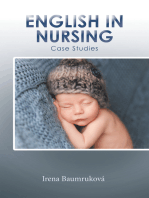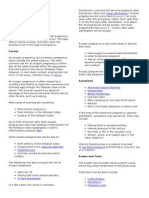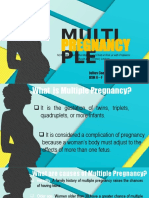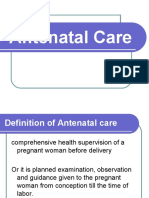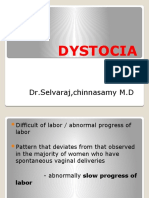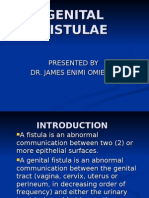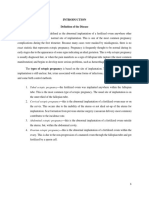Postpartum Hemorrhage
Postpartum Hemorrhage
Uploaded by
kman0722Copyright:
Available Formats
Postpartum Hemorrhage
Postpartum Hemorrhage
Uploaded by
kman0722Original Description:
Copyright
Available Formats
Share this document
Did you find this document useful?
Is this content inappropriate?
Copyright:
Available Formats
Postpartum Hemorrhage
Postpartum Hemorrhage
Uploaded by
kman0722Copyright:
Available Formats
GU: Postpartum Hemorrhage
Dr. Kaczmarczyk
10/13/11 9:00am-10:00 am
Class of 2014
christopherman@pcom.edu
Page 1 of 7
Note: From the Shoulder Dystocia lecture, the rate of shoulder dystocia (SD) recurrence
(slide 33) is a maximum of 16 percent. IF the mom has a recurrent SD, the risk of a brachial
plexus injury is as high as 40 percent.
1. Learning Objectives
a. Define postpartum hemorrhage (PPH)
b. Describe etiology of PPH
c. List PPH risk factors
d. Discuss medical management
e. Describe surgical management
2. PPH Definitions (need to know these)
a. Commonly defined as:
i. Spontaneous Vaginal Delivery > 500cc blood loss
ii. C-Section > 1000cc blood loss
1. Easier to use these two numbers clinically
iii. Considered to be an obstetrical emergency
b. Other Definitions:
i. Hematocrit Change > 10% (not useful in acute setting)
ii. Need for Transfusion and/or symptomatic
c. Primary (Early or Acute PPH)
i. Delivery to < 24h PP
ii. 90% PPH cases
iii. Associated with more bleeding (copious volumes of blood loss)
d. Secondary (Late PPH)
i. 24h 12 weeks postpartum
ii. Affects 1-3% all deliveries
iii. Common causes:
1. Infection (such as chorioamnionitis)
2. Retained products
a. IUFD- intrauterine fetal demise. The whole pregnancy is there
but the baby is dead
b. Retained part of a placenta or a secondary lobe separate from
the placenta
3. Abnormal uterine involution
a. If you have a very large uterus, it begins to involute very
quickly. In some women, it doesnt shrink back to its normal
size
3. PPH Epidemiology
a. Among top 5 causes maternal mortality (Including in the US)
b. #1 cause maternal mortality worldwide
i. Important for medical mission trips (know SD and PPH)
c. Developed countries 1/100,000 births vs. 1/1000 births in developing countries
d. Incidence 5% - 10% deliveries
i. depends on definition used
GU: Postpartum Hemorrhage
Class of 2014
Dr. Kaczmarczyk
christopherman@pcom.edu
10/13/11 9:00am-10:00 am
Page 2 of 7
4. Physiologic Adaptations of Pregnancy
a. All of these are physiological changes that take place that are true adaptations that
prepare the mom for delivery
i. Blood flows through the uterus at 500-800cc a minute
b. Plasma volume 40-50% increase
c. RBC 20-30% increase
d. Cardiac output 40% increase
e. Fibrinogen and factor VIII increase
5. Estimated Blood Loss (EBL)
a. All studies grossly underestimate EBL at delivery
b. Prasertcheroensuk et al. (2000)
i. 228 women in 3rd stage labor
ii. Visual estimation of blood loss (incidence 5.7% satisfied PPH criteria) vs.
measured (incidence 27.63%)
iii. Visually estimated EBL sensitivity 15.87%, specificity 98.18% and accuracy
75.35% (compared to direct measurement)
1. Sensitivity- ability to accurately identify someone who truly has the
condition of interest
iv. Incidence of PPH underestimated by 90% in visual estimations of EBL
1. Surgery tends to report a low EBL due to a number of pressures and
that we arent very good at identifying volumes
6. Blood Loss Signs & Symptoms
a. What happens if you lose a lot of blood at the time of delivery?
Blood Loss Vaginal to CBlood Pressure
Signs & Symptoms
Section (%)
500-1000ml (10-15)
Normal
Palpitations, dizziness,
tachycardia
1000-1500ml (15-25)
Slightly low
Weakness, sweating,
tachycardia
1500-2000ml (25-35)
70-80
Restlessness, pallor, oliguria
(decreased urinary output)
2000-3000ml (35-45)
50-70
Collapse, air hunger, anuria
7. Etiology of PPH
a. 4 vs 5 Ts
i. Tone (Uterine Atony)
1. Uterus doesnt contract (floppy organ)
ii. Tissue (Retained Products, see above)
iii. Trauma (Laceration in the birth canal)
iv. Thrombin (Coagulopathies)
v. Traction (Uterine Inversion)
1. Some people put traction in the trauma category for 4 Ts
2. See picture of this later in lecture
GU: Postpartum Hemorrhage
Class of 2014
Dr. Kaczmarczyk
christopherman@pcom.edu
10/13/11 9:00am-10:00 am
Page 3 of 7
8. Uterine Atony
a. 75-90% PPH mostly 10 PPH (early and acute PPH)
i. Cause of most PPH
b. 6% after C-section
c. Risk factors after C-section
i. Multiples (more than one baby)
ii. Hispanic ethnicity
iii. Induced or augmented labor (used oxytocin)
iv. Macrosomia
v. Chorioamnionitis
9. Retained Placenta or POC (Products of Conception)
a. Retained placenta- 10% PPH cases
b. 10% placentas fundal implantation
c. Placenta accreta 0.005% of all deliveries
i. Invasion of the trophoblast into the
myometrium behaving like a malignancy
ii. Placenta accretes will not separate normally
d. 90% accretas have PPH
e. 50% accreta undergo hysterectomy (abnormal placentation)
i. The more C-sections a woman has, the more likely she will have an abnormal
placentation including placenta accrete
10. Laceration or Uterine Inversion (Trauma category)
a. Etiology PPH 20% cases
b. Genital tract injury during delivery (Odds ratio of 1.7 with a vaginal delivery)
c. 65% uterine inversions have PPH
i. Completely iatrogenic. Excessive traction
before the placenta releases
d. 48% uterine inversions
i. require transfusion
e. Dr. K tells a story when a resident pulls the cord and
the
uterus comes out and invereted. To fix it, you push the
uterus right back up with a fist. You have seconds before the patient presents with
shock.
i. Know the signs of placental separation to avoid this!
ii. The uterus should have rapid involution and the normal supporting structures
should keep it inside
iii. Recurrence depends on the placenta placement (but usually a low rate)
11. Thrombin
a. Etiology 1% PPH
b. Known association with coagulation failure:
i. Abruption (premature separation of the placenta)
ii. Hypertensive disorders
iii. Sepsis
iv. IUFD
1. Told a story about a patient in the Indian Health Station that had two
IUFDs. Had a problem with medical compliance due to her
GU: Postpartum Hemorrhage
Class of 2014
Dr. Kaczmarczyk
christopherman@pcom.edu
10/13/11 9:00am-10:00 am
Page 4 of 7
background (navajo indian). She is at risk of DIC which can cause
PPH.
v. Incompatible blood
vi. Abortion (refers to miscarriage)
12. Risk factors in PPH
a. Table shows all the risk factors and describes their mechanism. Dr. K did not go
through the table, but mentioned that tone PPH can be increased with
polyhydraminos, multiple gestation and macrosomia.
b. Retained Placenta (OR 3.5)
i. Highest risk
c. Failure to Progress 2nd Stage (OR 3.4)
d. Placenta Accreta (OR 3.3)
e. Lacerations (OR 2.4)
f. Instrumental Delivery (OR 2.3)
i. Using either vacuum or forceps
g. Large For Gestation Age (OR 1.9)
h. Hypertensive Disorders (OR 1.7)
i. Induction of Labor (OR 1.4)
j. Augmentation of Labor With Oxytocin (OR 1.4)
GU: Postpartum Hemorrhage
Class of 2014
Dr. Kaczmarczyk
christopherman@pcom.edu
10/13/11 9:00am-10:00 am
Page 5 of 7
13. Factors Associated with PPH
a. DM 30-35% vs 5-10% non-DM
b. Inherited coagulopathies:
i. Von Willebrands Disease most common (guess this on rounds)
1. 1-3% prevalence
2. 70% have type 1
c. Risk PPH 22% with Von Willebrands
i. 18% in hemophilia
d. Important to get blood disease history!!
14. Additional Risk Factors for PPH
a. Age > 35y
b. Asian
c. Hispanic ethnicity
d. Obesity
i. Risk almost doubled by obesity in an article he read
ii. Hot topic in obstetrics
e. Post dates > 42 wks
f. Previous PPH
g. Placenta Previa (abnormal placentation)
i. When the placenta covers the internal os (inhibits a baby delivery)
15. Management
a. Prevention
b. Early Recognition
c. Immediate Appropriate Intervention
16. Initial Management
a. ABCs
b. Examine patient (fundal massageDx etiology)
c. Management determined by etiology
i. If atonyuterotonics
ii. Look for lacerationrepair it
iii. Management determined by etiology
d. IV access and fluid resuscitation
e. Foley catheter
f. Lab (CBC, coag profile, cross match)
g. Reverse coagulation abnormality if there is one
17. Uterotonic Medications (MEMORIZE THIS SLIDE)
a. Oxytocin (Pitocin or PIT)
b. Ergot (Methergine)
c. Hemabate (15-methyl-PGF2)
d. Misoprostol
i. Know this on your medical missions!! Easy access (PO or sublingual)
e. Vasopressin
GU: Postpartum Hemorrhage
Class of 2014
Dr. Kaczmarczyk
christopherman@pcom.edu
10/13/11 9:00am-10:00 am
Page 6 of 7
18. Medications Graph
a. Did not go over the graph specifically.
b. He uses hemabate in the Indian Health Service and inject it intramyometrially
i. Both Asian and Native American women are at risk for PPH
19. Surgical Management
a. Curettage
i. Scrapping whatever is inside the uterus out of the uterus
ii. Can be referred to as a banjo curette (large instrument)
b. Embolization
i. May be the uterine arteries
c. Tamponade (Balloon, packing- can use many yards of material!)
d. Compression sutures- very popular on exams
e. Vessel ligation
f. Hysterectomy
20. Tamponade
a. Definition: using something inside the uterus to
compress the uterus
b. Bakri Balloon
c. Foley catheter with 30cc balloon
d. Sengstaken-Blakemore Balloon (used for
esophageal varices)
e. Vaginal packing
f. Saline filled glove (good for medical missions)
i. Condom
GU: Postpartum Hemorrhage
Dr. Kaczmarczyk
10/13/11 9:00am-10:00 am
21. Vessel Ligation
a. Uterine
i. OLeary Stitch
ii. Chromic 0 passed through lateral aspect
of lower segment as close to cervix as
possible and then through broad ligament
lateral to vessels
b. Ovarian
i. Distal to cornua by passing suture
through myometrium medial to
vessels
c. Be careful of the ureter on both sides!!
22. B-Lynch Suture (FYI, but be aware of it)
23. Algorithm for PPH management
Class of 2014
christopherman@pcom.edu
Page 7 of 7
You might also like
- Recommended Actions After Late or Missed Combined Oral Contraceptives100% (1)Recommended Actions After Late or Missed Combined Oral Contraceptives2 pages
- 3 Problems With The Passenger and Powers of Labor100% (1)3 Problems With The Passenger and Powers of Labor105 pages
- Medical School Companion Obstetrics and Gynecology Practice Question BookFrom EverandMedical School Companion Obstetrics and Gynecology Practice Question Book3/5 (2)
- Abnormalities of Labour and Delivery and Their Management: Joó József GáborNo ratings yetAbnormalities of Labour and Delivery and Their Management: Joó József Gábor44 pages
- Psychological Perspective of Abnormal LaborNo ratings yetPsychological Perspective of Abnormal Labor25 pages
- Dystocia: DR - Selvaraj, Chinnasamy M.DNo ratings yetDystocia: DR - Selvaraj, Chinnasamy M.D54 pages
- Occipito-Posterior Position of The Fetal HeadNo ratings yetOccipito-Posterior Position of The Fetal Head8 pages
- High Risk Pregnancy Assessment and ManagementNo ratings yetHigh Risk Pregnancy Assessment and Management48 pages
- Complications During Labor and Delivery - HardNo ratings yetComplications During Labor and Delivery - Hard19 pages
- Bleeding Disorders During Pregnancy 1.threatened Miscarriage100% (1)Bleeding Disorders During Pregnancy 1.threatened Miscarriage12 pages
- Queenan's Management of High-Risk Pregnancy: An Evidence-Based ApproachFrom EverandQueenan's Management of High-Risk Pregnancy: An Evidence-Based ApproachNo ratings yet
- TABLE 254-11 - Converting From Parenteral To Oral AnticoagulanNo ratings yetTABLE 254-11 - Converting From Parenteral To Oral Anticoagulan2 pages
- Relationship Maintenance and Dissolution: Christopher R. Agnew and Laura E. VanderdriftNo ratings yetRelationship Maintenance and Dissolution: Christopher R. Agnew and Laura E. Vanderdrift24 pages
- Unas Mei 2020 (Sule) : Yang Dianggap Soal BaruNo ratings yetUnas Mei 2020 (Sule) : Yang Dianggap Soal Baru15 pages
- Depo-Provera - Wikipedia, The Free EncyclopediaNo ratings yetDepo-Provera - Wikipedia, The Free Encyclopedia13 pages
- System: Breastfeedilzg Charting and Documentation Tool100% (1)System: Breastfeedilzg Charting and Documentation Tool6 pages
- Inducing Labour With Acupuncture by Debra Betts PDF100% (2)Inducing Labour With Acupuncture by Debra Betts PDF6 pages
- Medical Record Prenatal and Pregnancy: Nestor Chicago J IL 60635 Kathy 333 East 3rd StreetNo ratings yetMedical Record Prenatal and Pregnancy: Nestor Chicago J IL 60635 Kathy 333 East 3rd Street11 pages
- 7.recent Advances in Contraceptive Technology100% (2)7.recent Advances in Contraceptive Technology25 pages
- The Obstetric Gynaecologis - 2021 - Jones - Detecting Endometrial CancerNo ratings yetThe Obstetric Gynaecologis - 2021 - Jones - Detecting Endometrial Cancer10 pages
- Various Sonographic Appearances of The Hemorrhagic Corpus Luteum CystNo ratings yetVarious Sonographic Appearances of The Hemorrhagic Corpus Luteum Cyst14 pages
- Comparative Anatomy of Female Reproductive System in Domestic AnimalsNo ratings yetComparative Anatomy of Female Reproductive System in Domestic Animals34 pages
- ALU 201 - The Academy of Life Underwriting IntermediateNo ratings yetALU 201 - The Academy of Life Underwriting Intermediate321 pages
- Webinar: National Institute of Disaster Management (NIDM) Ministry of Home Affairs, Government of IndiaNo ratings yetWebinar: National Institute of Disaster Management (NIDM) Ministry of Home Affairs, Government of India20 pages
- Traumatic Hypomenorrhea-Amenorrhea (Asherman'S Syndrome) : R. Toaff, M, D, S, Ballas, M.DNo ratings yetTraumatic Hypomenorrhea-Amenorrhea (Asherman'S Syndrome) : R. Toaff, M, D, S, Ballas, M.D9 pages
- Case Presentation: Ectopic Pregnancy: Intern in Charge: PGI Erick Rafael AncaNo ratings yetCase Presentation: Ectopic Pregnancy: Intern in Charge: PGI Erick Rafael Anca85 pages
- Recommended Actions After Late or Missed Combined Oral ContraceptivesRecommended Actions After Late or Missed Combined Oral Contraceptives
- Medical School Companion Obstetrics and Gynecology Practice Question BookFrom EverandMedical School Companion Obstetrics and Gynecology Practice Question Book
- Abnormalities of Labour and Delivery and Their Management: Joó József GáborAbnormalities of Labour and Delivery and Their Management: Joó József Gábor
- Bleeding Disorders During Pregnancy 1.threatened MiscarriageBleeding Disorders During Pregnancy 1.threatened Miscarriage
- Queenan's Management of High-Risk Pregnancy: An Evidence-Based ApproachFrom EverandQueenan's Management of High-Risk Pregnancy: An Evidence-Based Approach
- TABLE 254-11 - Converting From Parenteral To Oral AnticoagulanTABLE 254-11 - Converting From Parenteral To Oral Anticoagulan
- Relationship Maintenance and Dissolution: Christopher R. Agnew and Laura E. VanderdriftRelationship Maintenance and Dissolution: Christopher R. Agnew and Laura E. Vanderdrift
- System: Breastfeedilzg Charting and Documentation ToolSystem: Breastfeedilzg Charting and Documentation Tool
- Inducing Labour With Acupuncture by Debra Betts PDFInducing Labour With Acupuncture by Debra Betts PDF
- Medical Record Prenatal and Pregnancy: Nestor Chicago J IL 60635 Kathy 333 East 3rd StreetMedical Record Prenatal and Pregnancy: Nestor Chicago J IL 60635 Kathy 333 East 3rd Street
- The Obstetric Gynaecologis - 2021 - Jones - Detecting Endometrial CancerThe Obstetric Gynaecologis - 2021 - Jones - Detecting Endometrial Cancer
- Various Sonographic Appearances of The Hemorrhagic Corpus Luteum CystVarious Sonographic Appearances of The Hemorrhagic Corpus Luteum Cyst
- Comparative Anatomy of Female Reproductive System in Domestic AnimalsComparative Anatomy of Female Reproductive System in Domestic Animals
- ALU 201 - The Academy of Life Underwriting IntermediateALU 201 - The Academy of Life Underwriting Intermediate
- Webinar: National Institute of Disaster Management (NIDM) Ministry of Home Affairs, Government of IndiaWebinar: National Institute of Disaster Management (NIDM) Ministry of Home Affairs, Government of India
- Traumatic Hypomenorrhea-Amenorrhea (Asherman'S Syndrome) : R. Toaff, M, D, S, Ballas, M.DTraumatic Hypomenorrhea-Amenorrhea (Asherman'S Syndrome) : R. Toaff, M, D, S, Ballas, M.D
- Case Presentation: Ectopic Pregnancy: Intern in Charge: PGI Erick Rafael AncaCase Presentation: Ectopic Pregnancy: Intern in Charge: PGI Erick Rafael Anca
